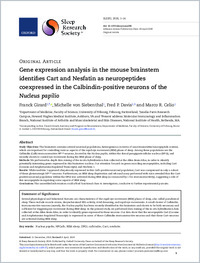Gene expression analysis in the mouse brainstem identifies Cart and Nesfatin as neuropeptides coexpressed in the Calbindin-positive neurons of the Nucleus papilio
- Girard, Franck Department of Medicine, Faculty of Science, University of Fribourg, Fribourg, Switzerland
- von Siebenthal, Michelle Department of Medicine, Faculty of Science, University of Fribourg, Fribourg, Switzerland
- Davis, Fred P. Janelia-Farm Research Campus, Howard Hughes Medical Institute, Ashburn, USA - Molecular Immunology and Inflammation Branch, National Institute of Arthritis and Musculoskeletal and Skin Diseases, National Institute of Health, Bethesda, USA
- Celio, Marco R. Department of Medicine, Faculty of Science, University of Fribourg, Fribourg, Switzerland
-
12.11.2020
Published in:
- Sleep. - 2020, vol. 43, no. 2020-11, p. zsaa085
English
Study Objectives: The brainstem contains several neuronal populations, heterogeneous in terms of neurotransmitter/neuropeptide content, which are important for controlling various aspects of the rapid eye movement (REM) phase of sleep. Among these populations are the Calbindin (Calb)-immunoreactive NPCalb neurons, located in the Nucleus papilio, within the dorsal paragigantocellular nucleus (DPGi), and recently shown to control eye movement during the REM phase of sleep. Methods: We performed in-depth data mining of the in situ hybridization data collected at the Allen Brain Atlas, in order to identify potentially interesting genes expressed in this brainstem nucleus. Our attention focused on genes encoding neuropeptides, including Cart (Cocaine and Amphetamine Regulated Transcripts) and Nesfatin 1. Results: While nesfatin 1 appeared ubiquitously expressed in this Calb-positive neuronal population, Cart was coexpressed in only a subset of these glutamatergic NPCalb neurons. Furthermore, an REM sleep deprivation and rebound assay performed with mice revealed that the Cart-positive neuronal population within the DPGi was activated during REM sleep (as measured by c-fos immunoreactivity), suggesting a role of this neuropeptide in regulating some aspects of REM sleep. Conclusions: The assembled information could afford functional clues to investigators, conducive to further experimental pursuits.
- Faculty
- Faculté des sciences et de médecine
- Department
- Département de Médecine
- Language
-
- English
- Classification
- Biological sciences
- License
- License undefined
- Identifiers
-
- RERO DOC 329922
- DOI 10.1093/sleep/zsaa085
- Persistent URL
- https://folia.unifr.ch/unifr/documents/309313
Statistics
Document views: 60
File downloads:
- cel_gea.pdf: 157
